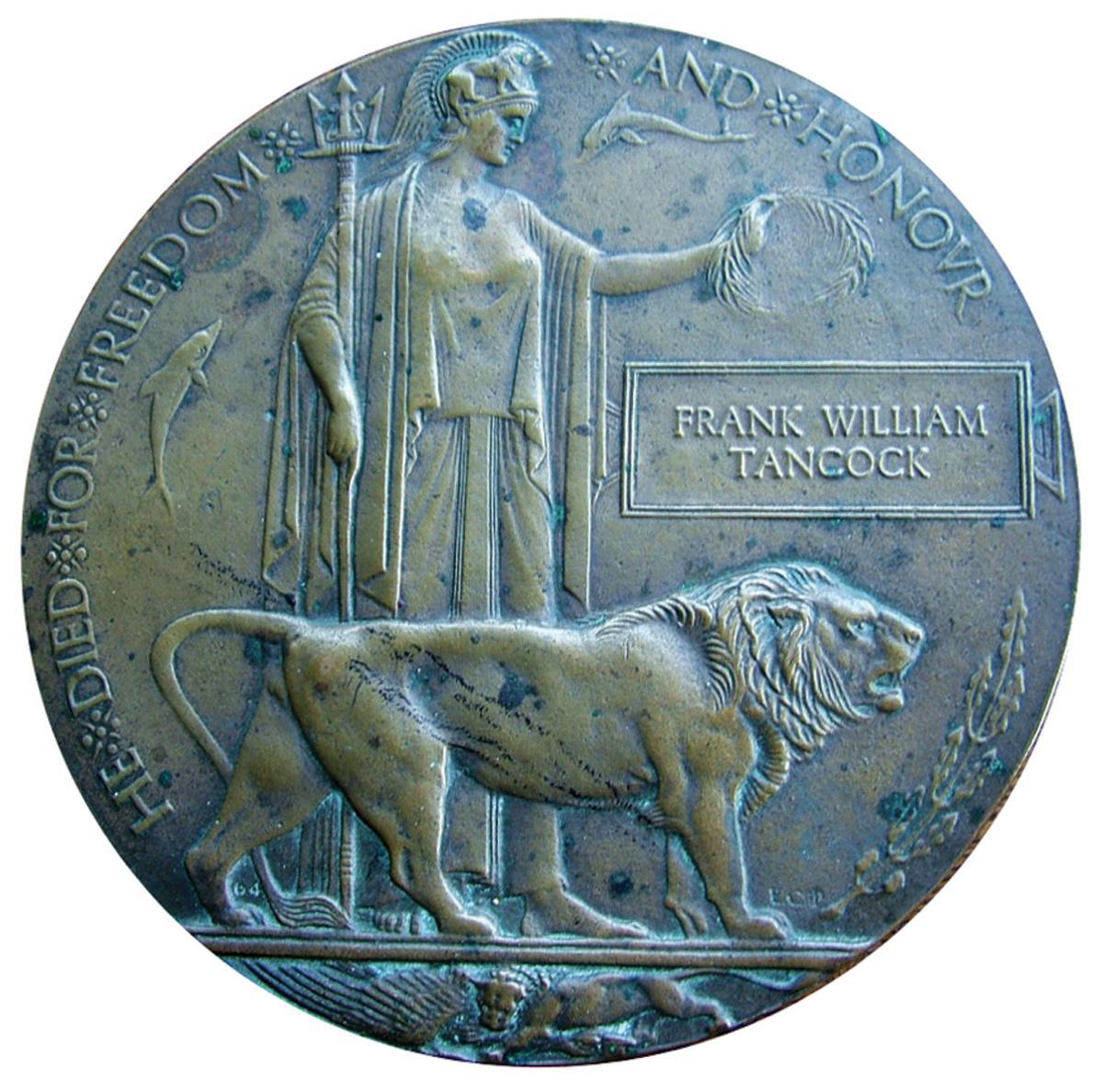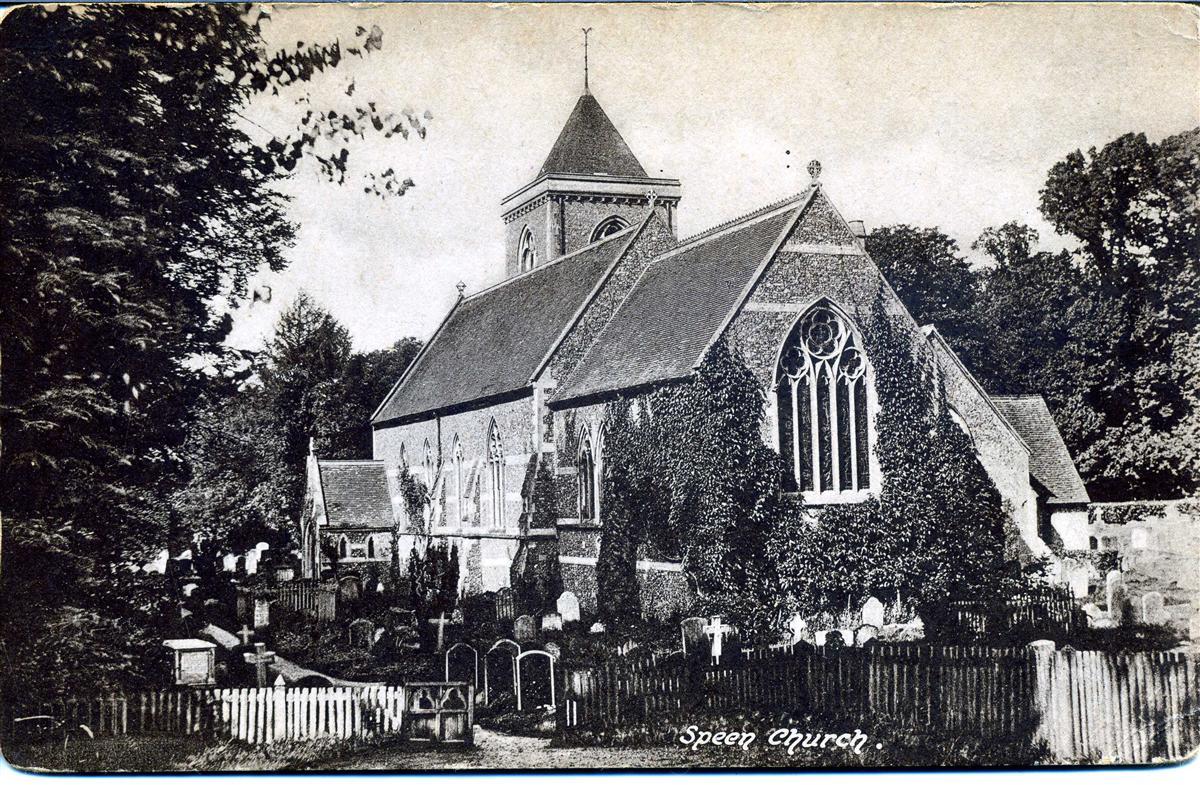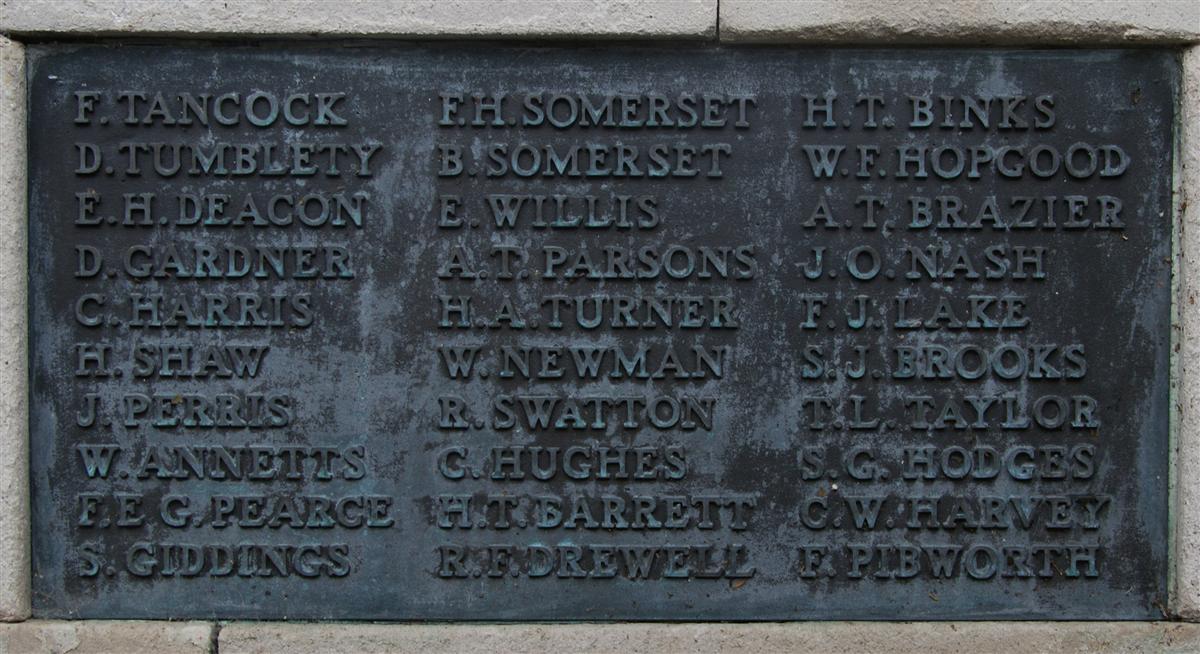Frank William Tancock
Private M2/019243 Frank William Tancock, Army Service Corps, Motor Transport
 Frank Tancock's 'death penny' (P D Goodall) |
Frank was born in Exeter on 23 December 1878 in the oddly named parish of St Mary Steps (to distinguish it from St Mary Arches; the church lies alongside a step hill with a stepped pavement). His parents, Frank William Edwards and his wife Maria (née Bragg), had married in the summer of 1878, suggesting that Frank jun may have influenced the decision to wed.
Frank sen was a bricklayer, a trade that was always in demand, though the building trade, then as now went through cycles of boom and recession. The family's move to Newbury, probably in 1900 coincided with a massive boom in house building. While it may well have been work that was the incentive to move there was a second more influential reason, and one that decided on Newbury as their destination. Maria Tancock's aging mother, Mary Atkins, owned a substantial house in Northcroft Lane - Northcroft Villa (since demolished to make way for the development of the Bewick's Reach appartment complex). Mary was widowed when her husband, and Maria's father, Charles Bragg died in 1870; two years later she remarried to Joseph Atkins. They were evidently an enterprising pair and had made enough money to retire in comfort to Newbury (Joseph's home town) in the 1880s. Joseph died in 1900 and 72 year-old Mary may well have welcomed the help and care her daughter could provide. Mary herself died in 1913, aged 85.
The move also gave Frank sen the opportunity to start a small business, although he is still calling himself a bricklayer in census returns, local directories include the entry F Tancock, mason alongside Mary Atkins' entry.
It seems likely that Frank jun moved to Newbury with his parents, but only for a short while; he was already of an age to make his own way in the world. By the time of the 1901 census he was employed as a footman at Barton Court, Kintbury (now the home of designer and Habitat founder, Sir Terence Conran). From there he moved on to become a chauffeur in Bradford on Avon after which he left domestic service and became a lorry driver.
On 14 June 1902 Frank married Nellie Crocker at St Mary the Virgin, Speen. Nellie had been working as a cook for a dressmaker in Kensington; her parents, George and Leah lived on Speen Hill.
When war broke out it was not long before he decided to enlist; he signed up in London on 14 November 1914. His peacetime occupation meant he was sent to the Army Service Corps to serve in Mechanical Transport as a driver. The BEF in France were evidently in great need of drivers; in those days he needed to do far more than drive, vehicles were far, far less reliable than today and any driver needed to be part mechanic - an experienced driver such as Frank would be a Godsend. Such was the demand that Frank landed in France on 18 November - with no time for more than the issue of a uniform and a lightning quick introduction to army life.
His role in France and Flanders was a vital one; he was posted to a Field Ambulance unit an spent his time transporting wounded men from Advanced Dressing Stations to Casualty Clearing Stations. The speed at which men could make this journey would often mean the difference between life and death, a good driver/mechanic would have been a lifesaver to many.
Frank's unit was attached to an Indian Division - it is not known which of the two that arrived in France that December. Both Divisions formed part of the Indian Corps, so their involvement in the fighting was very similar. Each division, the 3rd (Lahore) and 7th (Meerut) included three battalions of British infantry (one in each brigade) and were supported by five Field Ambulance units - two British and three Indian. The British units were the 7th, 8th Field Ambulances with the Lahore Division, and the 19th and 20th with the Meerut Division. Frank most likely served with one of these units. Each Field Ambulance (not to be confused with a field ambulance!) comprised 10 officers and 182 men from the RAMC and around 50 support staff (including ASC drivers etc). In battle they would run two Advance Dressing Stations just behind the lines (within yards) and a Field Dressing Station (a few hundred yards further back). At full strength they had stretcher bearers, horse drawn ambulances and two motor ambulances. The ambulances would be used to transport wounded men to Casualty Clearing Stations (in effect field hospitals) in safer locations well away from the front line.
The most commonplace danger Frank would have faced was enemy shellfire; not all of this was high explosive and shrapnel, gas shells were also used, especially to disrupt the allied artillery. It appears that Frank suffered a gassing at some point, though not so seriously as to merit inclusion in the medical notes in his pension records. However, it was this gassing that the family blamed for his subsequent development of tuberculosis. In February 1915 he was complaining of a cough and pain in his side, in June he reported sick and was diagnosed as suffering from pleurisy; subsequent tests showed he was infected with the tubercule bacillus. He was rapidly sent home for treatment.
On 19 August 1915 he was discharged from the Army as unfit to serve. At first he was deemed 50% disabled but this later became 100% as he underwent the further examinations required to annually assess his entitlement to a disability pension. His pension rose from 12/6 to 25/- (Feb 1917) and then to 27/6 (May 1917) - perhaps suggesting a worsening of his condition.
In 1916 he was admitted into a sanatorium at Whitwell on the Isle of Wight but he later returned home to Newbury finding accomodation in the cleaner air of Woolton Hill, just over the Hampshire border to the south of Newbury. Sadly his treatment was to no avail and he died at Woolton Hill on 27 January 1918.
His death was reported in the local paper:
Newbury Weekly News, 7 Feb 1918 p5 - A Soldier's Funeral
The death of Pte Frank William Tancock took place at Woolton Hill on Sunday, January 27. Deceased, who is the eldest son of Sapper and Mrs F Tancock, of Northcroft Villa, being of a mechanical turn of mind, went in for motor work, and on war breaking out he joined the ASC, MT, in August 1914. He was sent to the Front two days after joining, and was engaged among other things in bringing the wounded back to the base. He was eventually gassed, and after a time tuberculosis followed. Invalided home in the following June, he was discharged from the Army two years ago as medically unfit. He went to reside at Woolton Hill, hoping the fresh air and the smell of the pines would benefit him, but eventually passed away. The body was brought to Newbury, and the funeral took place at Speen Churchyard on Thursday, the Rev R Bruce Dickson officiating. He was awarded a soldier’s funeral, a bearer party and trumpeter being sent from the Royal Berks Depot at Reading. A number of wounded soldiers from the Newbury District Hospital, and several soldiers home on leave also attended. After the service at the graveside, the Last Post was sounded. The mourners were Mrs F W Tancock (widow), Sapper and Mrs F Tancock (father and mother), Pte Sam Tancock, King’s Own (brother), Mrs Coventry (sister), Mr Bragg (uncle), Mr J Crocker (brother-in-law), Mrs Carrell (sister-in-law). Also in church and at the graveside were Miss Thomas, Woolton Hill; Pte Culliford, Mrs T Crocker, Mrs J Crocker, Miss E Crocker, Mr C Bailey, Mrs Benham, etc. Floral tributes were sent bu his loving Wife; Dad and Mum; Brother Sam; Mabel and Fred; Binny; Aunt Lydia and Uncle Sam; Jack, Kate, and family; Annie, Edie, and Billy; Annie, Phyllis, and Tom; Eliza; Mr Jones; Jimmy; Mrs F Coventry; Mr and Mrs F Dore; old friends and neighbours; Tunbridge Wells Friendly Society; the Misses Egerton Green; Miss Thomas; Mrs Helsham Jones; Mrs F Stevens and Mr Andrews. Sapper Frank Tancock, father of deceased, joined up in the ASC in October 1915, and was drafted to Salonika, where he was wounded. Subsequently discharged as unfit, although 60 years of age, he joined the REs last August, and is still serving. A brother of deceased joined the King’s Own some two years ago. The name plate on the coffin was inscribed: “Frank William Tancock, born 23rd December 1878, died 27th January, 1918. RIP.” The funeral arrangements were carried out by Hart and Sons, Northcroft.

A contemporary photograph of St Mary the Virgin, Speen. |
As can be seen from the newspaper report his funeral in the churchyard at Speen was well attended. The grave is marked by a good quality granite surround; even though obscured by fairly unkempt grass the lettering is clear, reading: Frank William Tancock, late ASC MT, who died Jan 27th 1918, aged 37. and, at the foot of the grave He died that we might live.
Every serviceman who gave his life for his country in the Great War was elligible for a death plaque, a large bronze medal, also known as a dead man's penny because its design was reminiscent of the tails side of a old penny coin. The family was sent these together with a short message from the King; over the years many were discarded, sold, or lost and examples are regularly sold via online auctions sites like ebay. In 2008 Frank's plaque came up for auction and was purchased by a collector - who has kindly supplied a photograph (above).
 Frank's name on Newbury War Memorial (top left) |
Frank's name is not recorded on the national roll of honour held by the Commonwealth War Graves Commission, an ommission that will hopefully be rectified in the not to distant future. Evidence supporting his case for inclusion has been forwarded to the CWGC via the In From the Cold Project. Locally Frank is remembered on Newbury's Town War Memorial and also on a memorial board and a roll of honour in St Nicolas' Church, Newbury.
His father, Frank sen was evidently something of a character; his determination to serve his country meant that he lied about his age, telling the recruiting officer in 1915 that he was 47, when he was actually 57! Following his subsequent discharge as unfit he tried again enlisting in the Royal Engineers at the age of 60.
Frank jun's brother-in-law, Thomas Crocker, also gave his life in the Great War, dying in Gallipoli while serving with the Royal Goucestershire Hussars. He too is remembered on Newbury Town War Memorial.
Postscript
On 14 August 2014 Frank's name was added to the national roll of honour - link. This recognition of his status as one of the UK's war dead is a gratifying result of the work that also resulted in this story.
At present his name has been added to the United Kingdom Book of Remembrance - which can be viewed by appointment at the Commonwealth War Graves Commission (CWGC) offices in Maidenhead. This is a temorary expedient while a permanent commemoration is implemented. Had his burial place been unknown this would be on a new memorial erected in Brookwood Cemetery to hold the names of those recently discovered to have died in the UK and were overlooked by the CWGC. However, Frank's place of burial is known, so the CWGC should in time take over the maintenance of his grave and will in all likelihood add a marker to cleary identify it.
Thanks to Terry Denham at the In From the Cold Project.

Find a memorial :
| Died this day: | |
| 14 January 1942 | |
| Thomas Lodge | |
| Enborne |

Like this site? Show your appreciation through a donation to a great charity.